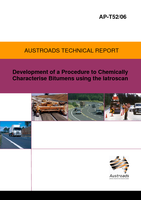Pavement

Development of a Procedure to Chemically Characterise Bitumens using the Iatroscan
- Publication no: AP-T52-06
- ISBN: 1 921139 49 8
- Published: 30 August 2006
- PDF (free) Download
This report gives information on the development of a procedure to fractionate bitumen using an Iatroscan liquid chromatography system, and also presents test results on a range of Australian bitumens. An introduction discusses the topic of bitumen fractionation and emphasises that all bitumen fractionation procedures are arbitrary - there is no widely accepted single way of categorising bitumen constituents.
- AP-T52/06 Development of a Procedure to Chemically Characterise Bitumens using the Iatroscan
- SUMMARY
- CONTENTS
- TABLES
- FIGURES
- 1. INTRODUCTION
- 1.1. Bitumen fractionation
- 1.1.1. The chemical makeup of bitumen
- 1.1.2. Defining bitumen fractions
- 1.1. Liquid chromatography
- 1.2. Operating principle of the Iatroscan
- 2. PROBLEMS WITH THE INSTRUMENT
- 2.1. Poor repeatability
- 2.2. Change in properties of the rods with time
- 2.3. Burning off asphaltenes
- 2.4. Apparent loss of material during development
- 2.4.1. Overview
- 2.4.2. Verification of problem using candle wax
- 2.4.3. Effect of spot size
- 2.4.4. Effect of scan speed
- 2.5. Selection of test conditions
- 2.5.1. Initial spotting and scanning conditions
- 2.5.2. Final conditions employing rapid spot deposition
- 3. SELECTION OF A DEVELOPMENT PROCEDURE
- 3.1. Introduction
- 3.2. Japanese Iatron laboratories method
- 3.3. German method
- 3.4. ARRB fraction development procedure
- 3.4.1. Introduction
- 3.4.2. Asphaltene determination
- 3.4.3. Development of the maltene fraction
- 4. THE USE OF CALIBRATION CURVES
- 4.1. Introduction
- 4.2. Column separation of bitumens
- 4.3. Preparation of calibration curves
- 5. ARRB FRACTIONATION PROCEDURE
- 5.1. General
- 5.2. Procedure
- 5.2.1. Precipitation of the asphaltene fraction
- 5.2.2. Development and testing of the maltene fraction
- 5.2.3. Calculation of the percentage of each fraction
- 6. TEST RESULTS FOR SAMPLES UP TO 1991
- 7. DISCUSSION
- 7.1. Relating chemical fractions to bitumen structure
- 7.2. Bitumen fractions and field performance
- 7.2.1. Colloidal instability
- 7.2.2. High temperature susceptibility
- 7.2.3. Tender bitumens
- 7.2.4. Asphaltenes vs saturates
- 8. CONCLUSIONS AND FUTURE WORK
- REFERENCES
- INFORMATION RETRIEVAL
Related publications
Latest Pavement News
